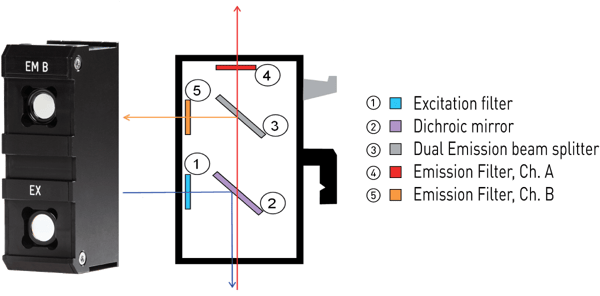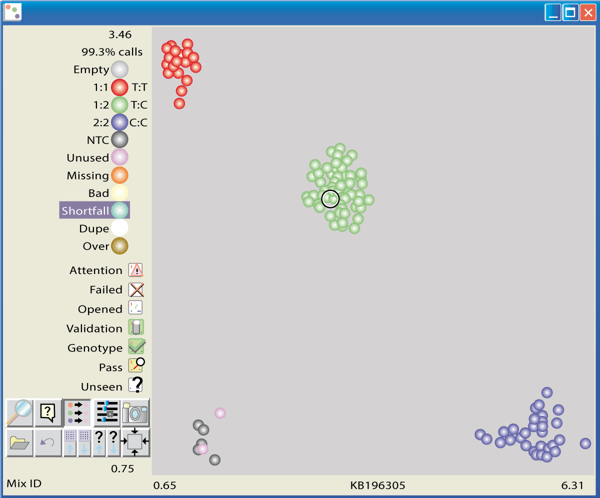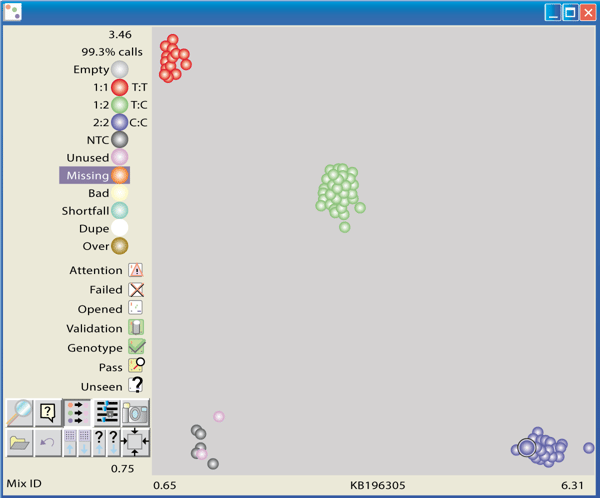Introduction
Single Nucleotide Polymorphisms (SNP`s) have become an invaluable tool in the field of genetic research. They are employed in a wide range of scientific fields from pharmacogenetics to animal breed identification through to disease gene mapping. They are a popular choice of genetic marker due to their ease of assay and analysis, however many standard assays remain relatively expensive to use in high throughput. In this application note we show the use of the PHERAstar® multimode plate reader for measurements in both SNP genotyping chemistry development and high throughput production genotyping. The KASP™ system, developed by KBiosciences (now LGC), was used to assess the performance enhancements of the PHERAstar, using a new SNP genotyping specific optical module with dual emission created by BMG LABTECH (Figure 1). Using two photomultipliers allows for improved accuracy and reduced read times by 30%.
Materials & Methods
All materials were sourced from Sigma Aldrich, with the exception of 384- and 1536-well microplates which were produced in house (Part Numbers – Pro 384 and 1536 respectively). Oligonucleotides were also sourced from Operon, Germany.
The chemistry used was a KBiosciences proprietary system based on a homogeneous Fluorescence Resonance Energy Transfer (FRET) detection system, using allele specific PCR. Briefly, two oligos are designed specific to each allele of the SNP. Each one of these oligos is tailed with an 18bp sequence distinct from each other. Also included in the reaction is Taq polymerase, dNTPs, an internal standard dye (Rhodamine X, (Rox)) and reverse primers.
Modified versions of Taq polymerase are unable to extend primers that are mismatched at their 3´terminal base. This is used to discriminate the two alleles. The reaction is monitored by the creation of fluorescence from two novel FRET reporter oligos that are included in the reaction. All reactions were conducted in a volume of 1 µl (1536-well plates) or 2 µl (384-well plates) and thermal cycled in a Hydrocycler thermal cycler (KBiosciences, Basildon, UK). The liquid handling was performed using a Deerac EquatorTM GX8 (Deerac Fluidics, Dublin, Ireland).
Results & Discussion
| FAM/ROX | Excitation 485 nm |
EmissionA |
EmissionB
520 nm |
| VIC/ROX | Excitation 520 nm |
EmissionA |
EmissionB
560 nm |
Figures 2 and 3 show the results obtained from measurements with different emission modules. The results show, sharper clusters are obtained when the dual emission module is used.
Conclusion
The PHERAstar has always performed this application well in the past but by introducing the SDE modules a further significant improvement in performance was achieved. In addition to this, the implementation of the dual optical modules at the KBiosciences production facility has resulted in an increased throughput of 30% due to the having to read each well only twice (Fam/Rox, then Vic/Rox) instead of each Fluor separately.
Finally, we have noticed that since implementation of the dual modules the mis-read rate of the PHERAstar has decreased to a level that is no longer measurable. After the initial evaluation, the whole production site of PHERAstars at the KBioscience facility has been upgraded to dual modules.
Background
LGC’s Genomics division combines with KBioscience LGC, the international science-based company and market leader in analytical, forensic, and diagnostic services and reference standards, announces that LGC’s Genomics division and KBioscience have come together to create a market-leading genomic services and solutions provider.
About KBioscience
KBioscience was a UK-based technology company focused on SNP Genotyping chemistry and novel instrumentation. Set up in 2002 to exploit the use of laser welding as a service-based science company in the SNP genotyping market, KBioscience has developed its own range of SNP genotyping chemistry and novel instrumentation.


